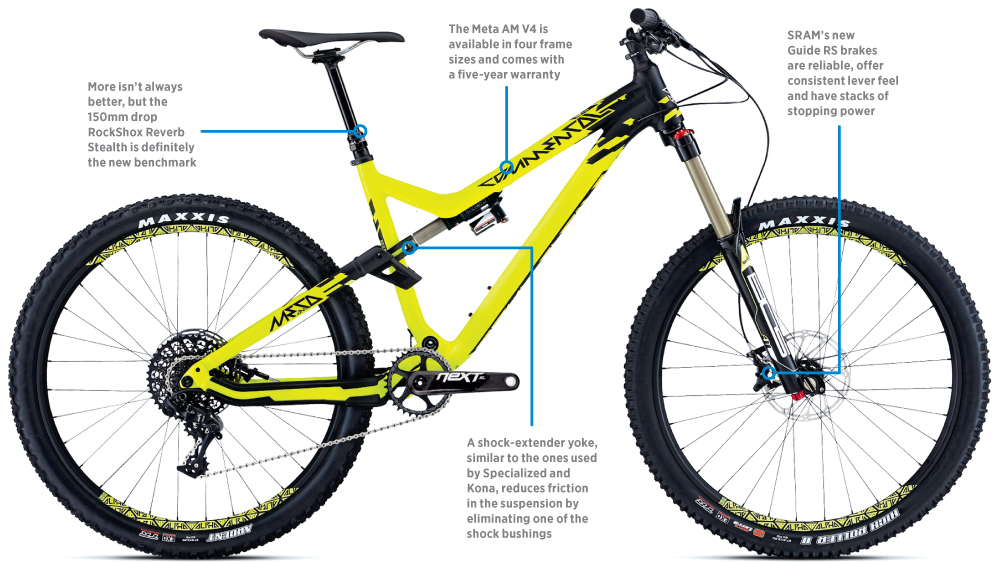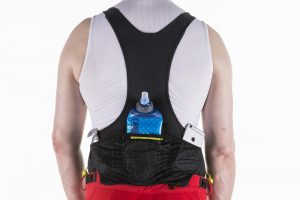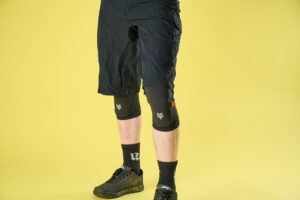A redesigned Meta AM and improved value for money promises good things for Andorran-brand, Commençal
Commençal Meta AM V4 ÀLC (2015) review
Commençal’s determined approach to reliability over the years has led to some hefty, over-built frames, but now the pendulum has started to swing back in the opposition direction. This Meta AM V4 À La Carte (ÀLC) weighs in at a sensible 13.69kg, which is only 300g heavier than the similarly specced Orbea — but it’s worth noting that both bikes pack over 1kg of excess baggage compared with the Giant Reign 27.5 1.
How does the fourth generation Meta AM stack up against the old version? Well, it still has 150mm of travel and retains Commençal’s Contact System suspension that’s based on a single-pivot design with a progressive shock linkage. The layout, however, has changed dramatically. The size of the links has been reduced and the shock is now partially concealed inside the top tube channel instead of being housed directly in front of the rear tyre as before.
The new layout certainly looks sleek but there are practical benefits too. Tucking the shock into the top tube gains extra standover clearance while preserving the desired layout of the suspension. It also creates extra space within the front triangle for a water bottle, even with the piggyback shock.
Less practical is the integrated post mount for the rear brake. By placing the caliper inboard of the non-driveside dropout the chainstays have been pushed out more. The consequence is that if you’re not rubbing your shoes on the stays with every pedal stroke, you’re constantly clipping them when shifting your body weight around to manoeuvre the bike. It’s the same mistake that Lapierre made on the Spicy, and hopefully the trend stops here.
Suspension
Up front, the 160mm-travel Bos Deville shares the same chassis as the one on the Orbea, but uses the 15mm axle instead of the 20mm. In addition to the three-way damping adjustment the fork also gets TRC technology that lets you instantly increase the spring progression at the flick of a lever. Turning the TRC on makes the fork feel more stable when sprinting, but there’s no loss in sensitivity. As such, it’s best reserved for super-steep trails where you need extra support up front.
The Bos Kirk rear shock also has high and low-speed compression and rebound adjustment, but the shock felt a bit sluggish to return, even with the rebound dial fully open.
Components
Neither bike in this test came fitted with a chain guide, but both have ISCG tabs. And, while we’d definitely recommend using a guide for racing, we never dropped the chain from the Race Face Next SL chainset. The smaller bearings of the PF92 BB are already on their way out and we don’t hold out much hope for bearings in the front hub either.
Performance
From the get-go, the Meta AM felt like a fun bike. Its choppered out fork, low-slung top tube and sensible BB height instantly had us up to speed, smashing turns, looking for jumps to boost off and generally mucking around. With its steep seat angle and long chainstays it cranked along at a blistering pace and climbed efficiently too.
Turn the heat up, however, and the Meta had our palms sweating more as we dived into high-speed rock gardens or rattled our way down steep, technical chutes. When push comes to shove it just doesn’t hold a line as well or provide the same level of composure as the Orbea. This is in part due to the shorter front end, but we can’t ignore the slightly laboured response of the Bos rear shock damping the Commençal’s spirit. The suspension is sensitive, but popping the bike or changing lines requires more effort than on the Orbea, especially when fatigue sets in. As such, the Meta AM V4 ÀLC still has some untapped potential. It’s hard to argue with the price, though.
>>>> Click here to find out more about geometry with our handy guide
Photographs: Rupert Fowler
Verdict
With cutting-edge geometry, innovative design and sensitive suspension, the new Meta AM V4 ÀLC is unmistakably a Commençal. It exhibited great pace on fast-flowing singletrack and was a blast to ride, but it didn’t feel as sure-footed as the Orbea on full-blown enduro trails. The direct sales business model guarantees that the specification is on the money, but it’s not all rosy. The extra wide stays resulting from the inboard position of the rear brake mount will pose a genuine clearance problem for riders with big feet, or anyone that rides with their heels in.





















